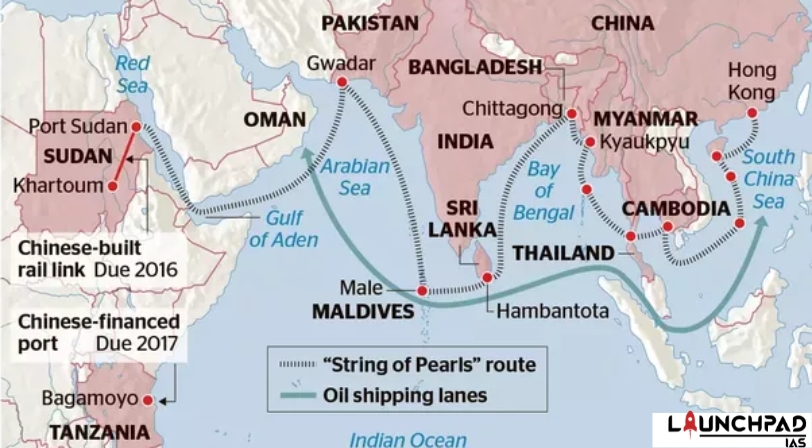What is China’s “String of Pearls” Strategy?
- The “String of Pearls“ is a geopolitical theory that refers to China’s increasing efforts to develop and expand its ports and naval bases throughout the Indian Ocean region, from the Strait of Malacca to the Horn of Africa.
- The theory suggests that China is seeking to establish a series of strategic naval bases and commercial ports along key sea lanes in the Indian Ocean, to protect its vital energy imports and enhance its maritime influence.
- These “pearls” include ports such as Gwadar in Pakistan, Hambantota in Sri Lanka, and Djibouti in Africa, which provide China with greater access and influence in the region.
- Belt and Road Initiative (BRI), sometimes referred to as the New Silk Road is another infrastructure project by China. It is also seen as part of China’s debt trap diplomacy.
Impact of String of Pearls on India:
- It endangers Indian maritime security. China is developing more firepower with more submarines, destroyers, vessels, and ships. Their presence will pose a threat to India’s security through the water.
- Impact on the Indian economy – Indian resources will be diverted towards defense and security. Thus, the economy will not reach its potential hampering economic growth. This may further lead to instability in India and the whole east and southeast region.
- The strategic clout of India which it enjoys today in the Indian Ocean will be reduced. China doesn’t have any openings in the Indian Ocean, the Strings of pearls will lead to China surrounding India and it will be able to dominate it. Countries that today consider India as a partner in response to China may end up in the lap of China.
What is India doing to Counter China?
- “Necklace of Diamonds” Strategy: This strategy aims at garlanding China or in simple words, the counter-encirclement strategy. India is expanding its naval bases and is also improving relations with strategically placed countries to counter China’s strategies. India’s strategic bases are:
- Chabahar Port – Iran
- Sabang port – Indonesia
- Sittwe port – Myanmar
- Mongla Port – Bangladesh
- Changi Naval Base – Singapore
- Forming groups with Like-minded Nations: India has made agreements for military cooperation in the region with Japan, Australia, and the USA. The four countries carry out joint military exercises in the IOR region, known as the ‘Quad’.
- Building Coastal Radar Networks: India is installing coastal systems in the countries in the Indian Ocean region such as Sri Lanka, Mauritius, Maldives, Seychelles, and Bangladesh. These radars will relay live images, videos, and location information of Ships moving in the Indian Ocean Region.
- The project is implemented by Bharat Electronics Limited (BEL).
- Act East Policy: This was launched as an effort to integrate India’s economy with South-East Asian nations. It has been used to make important military and strategic agreements with Japan, South Korea, Singapore, and Thailand helping India to counter China.
- Military and Naval Relationships: To upgrade and train its navy, India has developed a strategic naval relationship with Myanmar which gives India an increased footprint in the area.
- Strategic Investments: India has invested a lot diplomatically in countries like Turkmenistan, Uzbekistan, Kyrgyzstan, Kazakhstan, and Mongolia – all surrounding China. It also has recently extended over USD 1.75 billion in grants and credit to Myanmar.
Related Links: NUCLEAR SUPPLIER GROUP (NSG)


